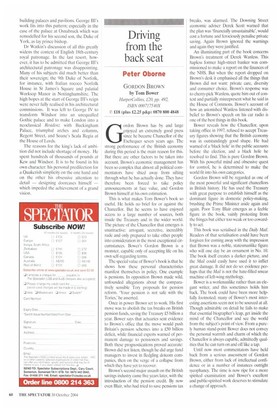Keen but could have done better
John Martin Robinson
THE ARCHITECT KING: GEORGE III AND THE CULTURE OF THE ENLIGHTENMENT by David Watkin Royal Collection Publications, 430, pp.224, ISBN 1902163508 © £26 (plus £2.25 p&p) 0870 800 4848 George III has had a poor posthumous press as the king who lost the American colonies and went mad. The biographies by John Brooke (1972) and Christopher Hibbcrt (1998) did much to rehabilitate his reputation at a personal and political level as a man of wide culture and a good and dutiful monarch who was struck down by a tragic illness now generally accepted to have been the rare disability, porphyria.
David Watkins new book, published to ._
coincide with the splendid exhibition of George III's collections in The Queen's Gallery at Buckingham Palace, concentrates on the king's architectural activities and patronage. Like many of his contemporaries, the princes and monarchs of northern Europe in the second half of the 18th century, architectural design and landscape improvement were the areas that interested him most; indeed in some ways he was obsessed by them.
George Ill had been taught architecture as part of his general education by the
internationally distinguished architect, Sir William Chambers. Hundreds of his designs for classical buildings still survive in the Royal Library at Windsor. Throughout his life Ile was involved in a series of architectural projects which varied in scale from a drawing in his own hand for a shepherd's cottage at Windsor to collaborating with Chambers on proposals for a grand new country palace at Richmond, The latter never materialised and Chambers had to content himself with remodelling Buckingham House for the king and the unique palace-office of Somerset House. Later James Wyatt began the Gothic transformation of Windsor and designed a huge castellated palace at Kew which was never inhabited and was demolished in 1827. There were also the great landscape gardens at Kew and Windsor, begun by his father and uncle respectively, which were
among the most influential in Europe.
The importance of Watkin's new book lies in the way he treats George Ill's activity in the context of German Enlightenment court culture, and not as a purely British phenomenon. The Georges (apart from the Prince Regent) are often dismissed as philistines, but this anglocentric view is far from the truth. The HanoverianBrunswick dynasty were Electors of Hanover and Arch-Treasurers of the Holy Roman Empire as well as kings of Great Britain and Ireland. Their work at Kew, Kensington and Windsor needs to be seen in tandem with the establishment of the botanical garden and university at Gattingen (the first modern university in Europe) by George II, and the botanical garden at Herrenhausen and the Society for Agriculture at Celle by George III.
George III saw himself as head of the premier court of the Protestant world, and this provided the inspiration behind his restoration of St George's Chapel, Windsor and bestowal of the Garter on many of his German princely cousins, rather in the way the Holy Roman Emperor gave the Golden Fleece to suitable Catholics. Frederick the Great was his first cousin, so was the Duke of Saxe-Gotha-Altenburg. The Landgrave of Hesse Kassel was his uncle and the Dukes of Brunswick and MecklenburgStrelitz his brothers-in-law. All were busy laying out new landscape gardens and building palaces and pavilions. George III's work fits into this pattern; especially in the case of the palace at Osnabruck which was remodelled for his second son, the Duke of York, as lay prince bishop.
Dr Watkin's discussion of all this greatly widens the context of English 18th-century royal patronage. In the last resort, however, it has to be admitted that George Ill's architectural patronage was disappointing. Many of his subjects did much better than their sovereign; the 9th Duke of Norfolk, for instance, with Italian rococo Norfolk House in St James's Square and palatial Worksop Manor in Nottinghamshire. The high hopes at the start of George HI's reign were never fully realised in his architectural commissions. It was left to George IV to transform Windsor into an unequalled Gothic palace and to make London into a neoclassical Residenz with Buckingham Palace, triumphal arches and columns, Regent Street, and Soane's Scala Regia at the House of Lords.
The reasons for the king's lack of ambition did not include shortage of money. He spent hundreds of thousands of pounds at Kew and Windsor. It is to be found in his own character: his personal predilection for a Quakerish simplicity on the one hand and on the other his obsessive attention to detail — designing doorcases himself — which impeded the achievement of a grand vision.



















































































































 Previous page
Previous page